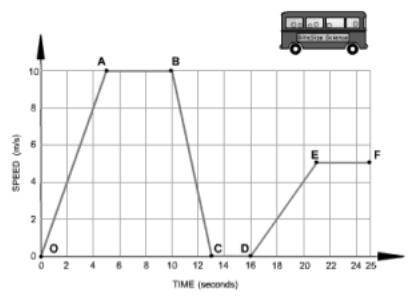
The graph below shows how the speed of a bus change during part of a journey. Use this graph to answer questions 3-5
3. In Segment B-C, the bus is
_ (accelerating;
decelerating; at rest; at constant speed)
Why?
4. In Segment C-D, the bus is
_ (accelerating;
decelerating; at rest; at constant speed)
Why?
5. Which Segment(s) is accelerating? How
do you know?


Answers: 2


Other questions on the subject: Physics

Physics, 21.06.2019 22:00, moneybaggzay123
1. consider the case in which air fills air shocks on a truck trailer. the pressure in the shocks is 2 mpa. the temperature is 300 k. the diameter of the shock piston is 10 cm and the initial length of the cylindrical cavity containing the compressed air is 40 cm. a. the truck is gradually loaded over a period of a day in a static setting. the temperature is held constant for the atmosphere and thus for the gas shock. calculate the compressibility of the air in the shock for this condition when the truck is initially being loaded. b. if the shocks were loaded in a dynamic setting by driving over bumps, what would be the compressibility? state your assumption. c. what is the initial load on the shock if the shock is in an atmospheric 100 kpa? d. if the shock is compressed using the process described in part a, and the air shock compressed air cavity length decreases to 20 cm, what is the additional load applied to the shock?
Answers: 2

Physics, 22.06.2019 12:00, laurenppylant
If two students are running down the hall toward each other, trying to get to class, and they have the same mass and acceleration, what will happen when they collide? will their forces cancel out or will each one experience a reaction?
Answers: 1

Physics, 22.06.2019 17:00, griffinkiley22
Two manned satellites approaching one another at a relative speed of 0.550 m/s intend to dock. the first has a mass of 2.50 ✕ 103 kg, and the second a mass of 7.50 ✕ 103 kg. assume that the positive direction is directed from the second satellite towards the first satellite. (a) calculate the final velocity after docking, in the frame of reference in which the first satellite was originally at rest.(b) what is the loss of kinetic energy in this inelastic collision? (c) repeat both parts, in the frame of reference in which the second satellite was originally at rest. final velocity(d) loss of kinetic energy = ?
Answers: 2

Physics, 22.06.2019 19:30, paulstanley972
Visualize the problem and identify special cases first examine the problem by drawing a picture and visualizing the motion. apply newton's 2nd law, ∑f⃗ =ma⃗ , to each body in your mind. don't worry about which quantities are given. think about the forces on each body: how are these consistent with the direction of the acceleration for that body? can you think of any special cases that you can solve quickly now and use to test your understanding later? one special case in this problem is if m2=0, in which case block 1 would simply fall freely under the acceleration of gravity: a⃗ 1=−gj^.
Answers: 1
You know the right answer?
The graph below shows how the speed of a bus change during part of a journey. Use this graph to answ...
Questions in other subjects:




Social Studies, 28.01.2020 09:31




Social Studies, 28.01.2020 09:31

Biology, 28.01.2020 09:31



